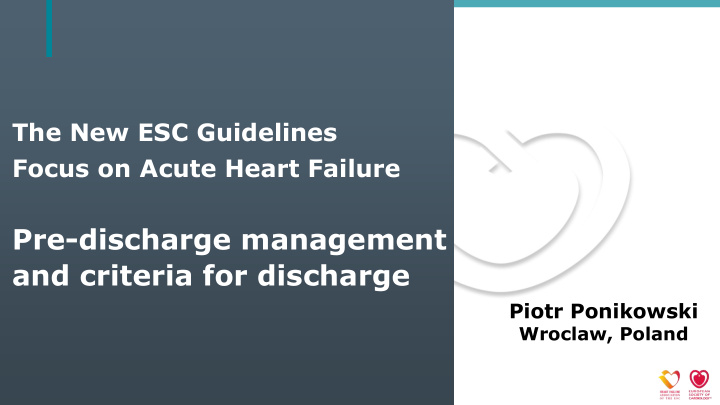



The New ESC Guidelines Focus on Acute Heart Failure Pre-discharge management and criteria for discharge Piotr Ponikowski Wroclaw, Poland www.escardio.org/guidelines
2 Disclosure Consultancy fees and speaker’s honoraria from: Amgen, Servier, Novartis, Johnson & Johnson, Merck, Berlin Chemie, Bayer, Cibiem, Vifor Pharma, Trevena, Abbott Vascular, Respicardia, and Cardiorentis Research support: Servier, Vifor Pharma, Singulex www.escardio.org/guidelines
www.escardio.org/guidelines
www.escardio.org/guidelines
The optimal management and timing in the management of acute heart failure Appropriate „timing” of each intervention Early intervention to improve Early initiation of „peri- Early initiation of long-term outcomes discharge phase” management regular check-up In-hospital Initial phase Discharge Early post-discharge (ED/ICU/CCU) phase follow-up phase Clinical tasks: • Defining goals of treatment • Characterizing patient’ clinical profile • Strategizing care • Monitoring effects of treatment
Goals of treatment in acute heart failure Immediate: Intermediate: • Improve organ perfusion & haemodynamics Pre-discharge and long-term • Identify aetiology and management: • Restore oxygenation relevant co-morbidities • Develop a careful plan that provides: • Alleviate symptoms • Titrate therapy to control a. schedule for up-titrating and symptoms and congestion • Limit cardiac & renal monitoring of pharmacological and optmize blood pressure damage therapy • Prevent thrombo- • Initiate and up-titrate b. need and timing for review for embolism disease-modifying device therapy • Minimize ICU length of pharmacological therapy c. who will see the patient and when stay • Consider device therapy in • Enrol in disease management appropriate patients ED/ICU/CCU programme, educate, initiate lifestyle In-hospital adjustments • Prevent early readmission Consecutive phases • Improve symptoms, QoL and survival of AHF management www.escardio.org/guidelines
Goals of treatment in acute heart failure Immediate: Intermediate: • Improve organ perfusion & haemodynamics Pre-discharge and long-term • Identify aetiology and management: • Restore oxygenation relevant co-morbidities • Develop a careful plan that provides: • Alleviate symptoms • Titrate therapy to control a. schedule for up-titrating and symptoms and congestion • Limit cardiac & renal monitoring of pharmacological and optmize blood pressure damage therapy • Prevent thrombo- • Initiate and up-titrate b. need and timing for review for embolism disease-modifying device therapy • Minimize ICU length of pharmacological therapy c. who will see the patient and when stay • Consider device therapy in • Enrol in disease management appropriate patients ED/ICU/CCU programme, educate, initiate lifestyle In-hospital adjustments • Prevent early readmission Consecutive phases • Improve symptoms, QoL and survival of AHF management www.escardio.org/guidelines
Pre-discharge management and criteria for discharge Identify aetiology and relevant co-morbidities www.escardio.org/guidelines
Pre-discharge management and criteria for discharge Identify aetiology and relevant co-morbidities Coexistence of two clinical conditions – ACS and AHF – always identifies a very-high-risk group where an immediate invasive strategy with intent to perform revascularization is recommended, irrespective of ECG or biomarker findings Recommendations for coronary angiography in chronic HF www.escardio.org/guidelines
Pre-discharge management and criteria for discharge Identify aetiology and relevant co-morbidities Iron deficiency in acute HF (new definition): • depleted body iron stores (low serum hepcidin) • insufficient iron amount in metabolizing cells (high serum sTfR) % of AHF pts 80% 75% of AHF - impaired iron status 60% 40% 20% Preserved Isolated Isolated Iron deficiency iron status high sTfR low hepcidin (↓hepcidin & ↑sTfR) www.escardio.org/guidelines Jankowska EA et al. Eur Heart J 2014;35:2468-76
Pre-discharge management and criteria for discharge Titrate therapy to control symptoms and congestion and optmize blood pressure www.escardio.org/guidelines
Pre-discharge management and criteria for discharge Titrate therapy to control symptoms and congestion and optmize blood pressure www.escardio.org/guidelines
Pre-discharge management and criteria for discharge Initiate and up-titrate disease-modifying pharmacological therapy www.escardio.org/guidelines
Pre-discharge management and criteria for discharge Initiate and up-titrate disease-modifying pharmacological therapy „in the case of haemodynamic instability/contraindications the daily dosage of oral therapy may be reduced or stopped temporarily until the patient is stabilized. In particular, β-blockers can be safely continued during AHF presentations except in cardiogenic shock.” www.escardio.org/guidelines
Therapeutic algorithm for a patient with symptomatic HFrEF www.escardio.org/guidelines
Therapeutic algorithm for a patient with symptomatic HFrEF Urgent need for discharge protocols in order to initiate disease-modifying therapies before hospital discharge www.escardio.org/guidelines
Criteria for discharge from the hospital and follow-up in high-risk period Patients admitted with AHF are medically fit for discharge: when haemodynamically stable , euvolemic , established on • evidence-based oral medication and with stable renal function for at least 24 h before discharge once provided with tailored education and advice about self-care • www.escardio.org/guidelines
Assessment of prognostic variables during discharge and early post-discharge period EXPECTED OUTCOMES Prevention of fluid Symptomatic Prognostic overload improvement improvement Clinical signs of congestion +++ + ++ blood pressure + ? + heart rate ? + + orthostatic test + ? ? ECG QRS duration (for CRT) + ++ +++ AF / tachyarrhythmias + ? + ++ Laboratory examinations myocardial viability + + ++ (?) natriuretic peptides ++ + + renal function / electrolytes + + / 0 + / ++ (?) anaemia / iron deficiency ? ++ + www.escardio.org/guidelines Metra M et al. Circulation 2010;122:1782-5
Grading Congestion Gheorghiade M et al. Eur J Hear Fail 2010,12,423-33
20 Pre-discharge management and criteria for discharge Develop a careful plan that provides: a. schedule for up-titrating and monitoring of pharmacological therapy b. need and timing for review for device therapy c. who will see the patient and when Patients should be: enrolled in a disease management program • seen by their general practitioner within 1 week of discharge • seen by the hospital cardiology team within 2 weeks of discharge • (if feasible) www.escardio.org/guidelines
Three-phase terrain of lifetime readmission risk after Heart Failure Hospitalization periods of highest risk for readmission unavoidable readmissions www.escardio.org/guidelines Desai AS and Stevenson LW .Circulation. 2012;126:501-506
Recommend
More recommend